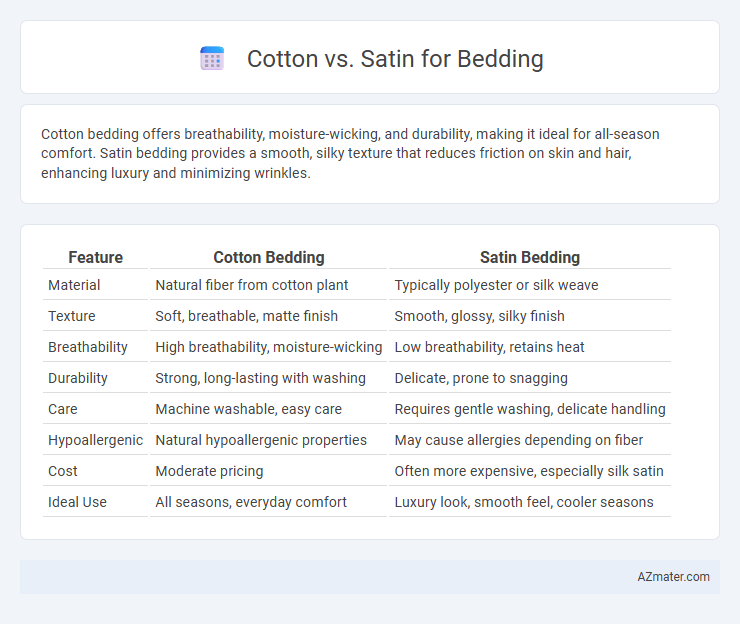Cotton bedding offers breathability, moisture-wicking, and durability, making it ideal for all-season comfort. Satin bedding provides a smooth, silky texture that reduces friction on skin and hair, enhancing luxury and minimizing wrinkles.
Table of Comparison
| Feature | Cotton Bedding | Satin Bedding |
|---|---|---|
| Material | Natural fiber from cotton plant | Typically polyester or silk weave |
| Texture | Soft, breathable, matte finish | Smooth, glossy, silky finish |
| Breathability | High breathability, moisture-wicking | Low breathability, retains heat |
| Durability | Strong, long-lasting with washing | Delicate, prone to snagging |
| Care | Machine washable, easy care | Requires gentle washing, delicate handling |
| Hypoallergenic | Natural hypoallergenic properties | May cause allergies depending on fiber |
| Cost | Moderate pricing | Often more expensive, especially silk satin |
| Ideal Use | All seasons, everyday comfort | Luxury look, smooth feel, cooler seasons |
Introduction: Cotton vs Satin Bedding
Cotton bedding offers natural breathability, moisture-wicking properties, and durability, making it ideal for year-round comfort. Satin bedding, made from silk or synthetic fibers like polyester, provides a smooth, luxurious feel with a glossy finish that reduces friction on hair and skin. Choosing between cotton and satin depends on preferences for temperature regulation, texture, and maintenance requirements.
Key Differences Between Cotton and Satin
Cotton bedding is prized for its breathability, moisture absorption, and natural softness, making it ideal for temperature regulation and everyday comfort. Satin bedding, typically made from silk or synthetic fibers like polyester, offers a smooth, glossy finish that reduces friction on skin and hair, enhancing a luxurious feel and minimizing hair breakage. The key differences lie in fabric composition, texture, breathability, and care requirements, with cotton being more durable and easy to maintain, while satin excels in aesthetic appeal and silkiness.
Comfort and Feel: Which Fabric Wins?
Cotton bedding is highly breathable and soft, providing a natural warmth and moisture-wicking ability that enhances comfort during sleep. Satin, with its smooth and glossy finish, offers a luxurious silk-like feel that reduces friction on skin and hair, promoting a cooler touch. For those prioritizing breathability and softness, cotton wins, while satin excels in delivering a sleek, slippery texture ideal for a more indulgent sleep experience.
Breathability and Temperature Regulation
Cotton bedding excels in breathability and moisture-wicking, allowing air to circulate freely and keeping sleepers cool and dry throughout the night. Satin, typically made from polyester or silk, offers a smooth, luxurious feel but tends to trap heat and moisture, which can lead to a warmer sleeping environment. For optimal temperature regulation and breathability, cotton is generally the superior choice, especially in warm or humid climates.
Durability and Ease of Care
Cotton bedding offers excellent durability due to its strong natural fibers, with high-quality Egyptian or Pima cotton lasting for years even after multiple washes. Satin, often made from polyester or silk blends, provides a smooth, luxurious feel but requires more delicate care to maintain its sheen and avoid snags. Cotton is typically easier to care for with machine washable and wrinkle-resistant properties, while satin demands gentle cycles or hand washing and careful handling to preserve fabric integrity.
Hypoallergenic Properties and Skin Health
Cotton bedding, known for its natural hypoallergenic properties, is less likely to cause skin irritation or allergies, making it ideal for sensitive skin. Satin, often made from synthetic fibers, may trap heat and moisture, potentially aggravating skin conditions and causing discomfort. Choosing cotton ensures breathability and moisture-wicking, which supports healthier skin by reducing acne and irritation risks.
Aesthetic Appeal and Style Options
Cotton bedding offers a classic, timeless look with a matte finish and versatile options ranging from crisp percale to soft sateen weaves, making it suitable for both casual and elegant bedroom styles. Satin sheets provide a glossy, luxurious sheen that enhances bedroom aesthetics with a smooth, silky texture, often associated with high-end, sophisticated decor. Style options for cotton include various patterns and colors appealing to minimalistic and traditional tastes, while satin typically elevates room ambiance through its reflective surface and rich appearance.
Cost Comparison: Cotton vs Satin Bedding
Cotton bedding generally costs less than satin due to its widespread availability and natural fiber sourcing, with prices ranging from $20 to $100 per set depending on thread count and quality. Satin bedding, often made from synthetic fibers like polyester or silk blends, typically falls between $40 and $200, reflecting its luxurious texture and production complexity. Consumers balancing cost and comfort often choose cotton for affordability and breathability, while satin appeals to those prioritizing smoothness and a premium aesthetic despite higher prices.
Sustainability and Environmental Impact
Cotton bedding, particularly organic cotton, is favored for its renewable nature and biodegradability, though conventional cotton cultivation demands high water and pesticide use, impacting ecosystems. Satin, often made from synthetic fibers like polyester, involves petroleum-based production processes that contribute to greenhouse gas emissions and non-biodegradable waste. Choosing organic or recycled satin blends promotes sustainability by reducing resource consumption and environmental pollution compared to conventional options.
Choosing the Best Bedding for Your Needs
Cotton bedding offers breathability and moisture-wicking properties, making it ideal for warm climates and sensitive skin. Satin provides a smooth, luxurious feel that reduces friction, benefiting hair and skin while offering a cooler touch in cooler environments. Selecting between cotton and satin depends on factors such as temperature preferences, skin sensitivity, and maintenance requirements to ensure optimal comfort and durability.

Infographic: Cotton vs Satin for Bedding
 azmater.com
azmater.com